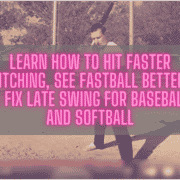Flat Bat Path On Swing Plane Spine Angle Baseball Softball Line Drive Hitting Drill Secrets | Getting Better At Batting By Yourself Tips For Beginners
Discover the flat bat path baseball and softball (slow pitch too!) line drive hitting drill secrets to setting the spine angle to get the swing on plane with the pitch. Learn beginner tips on how to get better at batting by yourself.
Adrian Beltre Swing Breakdown: Can Driving the Ball Be This Simple?
This weekend I had the great opportunity to work with a professional hitter Zack Esquerra, from the San Diego area, who was recently released after a couple years in the Diamondbacks organization on this very topic.
In this post, We’ll go over how easy it can be to drive the ball by simply changing the position of the back leg during the Final Turn. We’ll use Adrian Beltre’s swing as a model and go over:
- Adrian Beltre: pitch-plane mastery,
- Role of back leg during the Final Turn, and
- #1 drill to fixing a faulty back leg angle…
Adrian Beltre: Pitch-Plane Mastery
Adrian Beltre is a great example of a smaller hitter (5’11”, 220-pounds) having to do it right to compete with bigger ones. Here’s what he does so well:
- Gets low,
- Back leg angle (stays low),
- Barrel is short to plane of the pitch, and
- Barrel stays on pitch-plane…
Interesting to note, Adrian Beltre is below average with his ground-ball and strikeout percentages, and above average with his home-run to fly-ball ratio. Most of the hitters I first see – Zack included – have this reversed! Here are a few of Adrian Beltre’s key offensive Metrics:
Check out this slow motion clip of Adrian Beltre (different clip from the main video above)…look how he almost “snipes” the catcher’s glove!
Role of Back Leg During Final Turn
Homer Kelly says this in his book The Golfing Machine:
“The slant is up in the direction of a straightened Knee. The slant of the Hips affects the degree of the Hip Turn. Actually, the primary function of Knee Action – as with Waist Bend – is to maintain a motionless Head during the Stroke.”
Homer Kelly’s statement has as much to do with hitting as it does with the golf swing! During the Final Turn, Adrian Beltre uses his flexed back knee (and straightened front one) to slant his body up towards the downward traveling pitch. This was an immediate challenge with Zack’s swing, but once we quickly corrected it, we saw ball flight go from knee level line drives and in the ground, to head level line drives and driving the ball in the gap.
#1 Drill to Fixing a Faulty Back Leg Angle
CLICK HERE to view this post to learn more about the Art of Variance. Here’s how to do the Back Foot Variance Drill:
ONE FINAL NOTE: Adrian Beltre stays on the plane of the pitch so well during the Final Turn, I think he does it to a fault. You’ve seen the pictures of him sometimes finishing with his back knee on the ground (pictured above)? This can be caused by trying to stay low on the pitch-plane with too wide a base. In other words, his back foot doesn’t follow his front much after the stride, resulting in his feet being too far apart. He would be more efficient if he “skipped” the back foot forward a little bit during the Final Turn and maintained more of a bend (90-100 degrees) in the back leg.
- Fix Late Swings Fast: 2025 Pitch Recognition & See-Decide-Swing Training for Youth Baseball Power Hitters - October 6, 2025
- Safe Youth Weighted Bat Training: Proven Overload/Underload Drills to Increase Exit Velocity in Games Starting Tonight - September 29, 2025
- AI Coaching Course 2025: Youth Baseball & Softball Practice Plan + Off-Season & In-Season Workout Builder Fast - September 23, 2025














Joey,
Took the time to go back to read this article. This is one of the most critical pieces you have done. I realized what the back foot does, especially with Mantle, Mays, Sheffield, Aaron, Canseco, Cabrera, and others. But I never truly appreciated just how significant this action is. Thanks for enlightening me.
Joe
Glad you got a lot out of this Joe. The back foot is about stabilizing and setting the upward barrel angle. Too much back foot movement or too little, and the pitch-plane is compromised. It’s the Goldilocks Syndrome 😉
Goldilock’s syndrome? Is that some type of dissociative identity disorder?
Oh, I got it. Too hot, too cold, just right?
Joey,
It’s not so much that Beltre isn’t skipping his rear foot, he is moving it, though he is dragging it. This causes friction and prevents the foot from getting on the upward plane. So, it is the dragging of the back foot that impedes his movement and follow through. Am I correcting in that interpretation?
Joe
Joe, some hitters skip the foot, some drag, and some just go up on the toe. All are okay, IF the back knee can keep the 90-degree bend during the turn and after contact.
When I was watching this and listening to your quote from Homer Kelly, I expected you to draw the line at 2:10 from the back foot up the lower leg and through the front knee. After watching the whole thing, trying to see if how I interpreted Homer Kelley’s words might fit also, I went back and took a screenshot of 2:10 and it turns out that there is a line almost perfectly parallel to the one you draw through the hips that starts at the heel of the back leg, passes through the top of the back knee and the bottom of the front one.
I don’t see any way you could teach a hitter to work on making the hip angle, bat plane, and line from back heel to from knee all be parallel – without video – but it’s pretty cool the way all three seem to line up.
Great observation again Alan! You’re correct with that. The barrel should be swung ‘level’. But it’s the back knee that sets the upward plane of the barrel to match the downward plane of the ball. Not the hands and arms. You can teach this by telling a hitter to stay short (height-wise) during the Final Turn with the back knee.
Joey,
Please tweet this article to Mark DeRosa on MLB Central. Did you catch his explanation for Adrian Beltre’s penchant for dropping to his back knee on some of his swings? You have to see it.
Thanks Joe, I’ll have to check it out. I think DeRo is sprinting up a steep learning curve right now, and I would take what he has to say with a grain of salt.
He is very influential in these parts with that show. Has a convincing tone of voice and a confident delivery. That works for a lot of people. He also dissed the hunched posture.